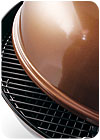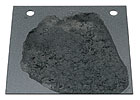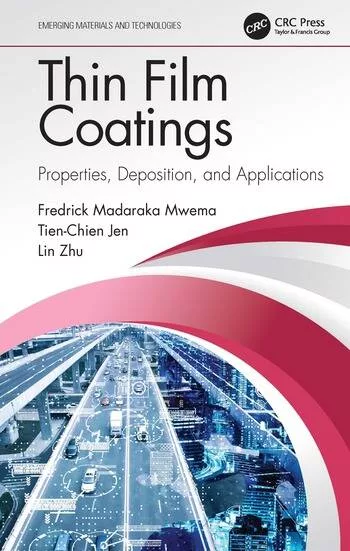Boosting Appliance Appeal

Copper Evolution™, a metallic-look porcelain enamel coating, provides a durable, cost-effective finish on a grill.
Appliance designers face a difficult task. The cost of stainless steel and other materials continues to increase, yet prices must be kept low to drive consumer purchases without compromising style or performance. How can these seemingly opposing goals be achieved? Ceramic finishes offer a solution. New porcelain enamel-derived coatings are taking today’s stylish home and industrial finishes to a higher level, with performance that maintains beauty to build long-term brand popularity.

Figure 1. Stainless-Style Evolution™ on a range (photo courtesy of Whirlpool® Corp.).
Durable Metallic Finishes
Metallic surfaces, special effect colors and reflective finishes increasingly have found their way into product design. The metallic trend shows no sign of slowing, but the growing demand for stainless steel appliances, outdoor grills, fire bowls and decorative items has dramatically boosted base metal prices. For example, 304 stainless steel typically used for appliances contains 8 to 10.5% nickel. According to USGS Minerals Information, about two-thirds of all nickel production was earmarked for stainless steel in 2005. Cost data from the London Metals Exchange shows a steep price jump, with nickel prices nearly quadrupling from $5.40/lb in December 2005 to $22.78/lb in 2007 before falling back slightly in 2008.1 Copper, chrome and other metal prices have risen sharply as well.Appliance designers have taken these sharp cost increases on the chin. Fortunately, new developments in porcelain enamels are presenting a more cost-effective alternative. These engineered coatings give trendy metallic looks with a substantially lower price.
Using these new coatings, designers can fabricate a range or another appliance from 24-gauge enameling steel instead of 300 series stainless. The coating would be applied as a 0.002 in. (2 mil) ground coat and a 0.004 in. (4 mil) cover coat. Using general market prices, the metallic-look porcelain enamel could reduce costs by nearly 50% compared to stainless steel. The porcelain coating also withstands scratches that typically damage a significant percentage of stainless steel parts during fabrication, turning them into scrap. Porcelain enamel- coated parts also lend themselves to the superior forming characteristics of carbon steel versus the more difficult to form stainless steel.
Coating colors developed to date include several shades of stainless, mirror finishes and copper. Figure 1 shows a stainless-style porcelain enamel-coated range.
The coating is applied and fired like conventional porcelain enamel. It provides the benefits of enamels such as:
- Sanitary qualities
- Easy cleaning
- Superior scratch and abrasion resistance
- Superior chemical and corrosion resistance
- Flame resistance
- Color stability
- A low environmental impact with zero solvents

Figure 2a. After soaking test panels soiled with baked-on strawberry jam in soapy water for 15 minutes, the AquaRealEase™ panel (above) wiped completely clean, but the pyrolytic panel (below) retained significant soil.
Steam-Cleanable Surfaces
Oven cleaning technology consists of three types: self-cleaning pyrolytic ground coats, non-self-cleaning ground coats or catalytic continuous-clean enamels. The first reduces foodstuffs to ash with exposure to temperatures between 900 and 1,000°F (482 and 538°C), while the second requires harsh alkaline cleaners to remove soils. The third, which largely has fallen out of use, relies on porous enamels to catalyze the reduction of soils to ash at normal cooking temperatures.Innovations in porcelain enamel technology are providing a new alternative. These coatings allow baked-on food residues to be released with exposure to moisture (either as water or steam), thereby offering a more environmentally friendly and energy-efficient option to cleaning ovens without the use of harsh chemicals, high temperatures and the resulting fumes in the kitchen. Additionally, interlocks and extra insulation are not required, freeing oven manufacturers to add other features such as advanced electronics or integration into a home network to the previously old-fashioned range.
These advanced coatings can be applied in a single coat over existing oven finishes. They have the mechanical durability and superior thermal resistance of traditional enamel, can be applied to steel in a single fire, and fire out between 1470 and 1570°F (799 and 854°C).
Figure 2 shows the comparative cleaning results of test panels coated with traditional pyrolytic enamel and the new porcelain enamel technology. Strawberry jam was baked on both panels at 450°F (232°C) for one hour, then the soiled panels were soaked in soapy water for 15 minutes. The porcelain enamel panel wiped completely clean, while the pyrolytic panel retained significant soil.

Figure 2b. The strawberry jam-coated pyrolytic panel.

Figure 3. A toaster oven coated with the nonstick RealEase® ceramic composite finish.
Nonstick Solutions
New ceramic composites combine the cleanability of organic nonstick coatings, such as polytetrafluoroethylene (PTFE), with the hardness and durability of a ceramic coating. Some of the benefits of the coating include:4- Cleanability equal to PTFE coatings and superior to stainless steel
- A pencil hardness of 8H
- Superior heat resistance compared to PTFE coatings
- Conformability to U.S. Food and Drug Administration (FDA) requirements
- A low environmental impact with zero solvents
The coatings can be applied to a variety of substrates, including aluminum, stainless steel, aluminized steel, cast iron, enameling steel and ceramic. For aluminum and stainless steel, roughening with blasting is required, while aluminized steel only needs an alkaline degrease. For cast iron and steel, the light application of a proprietary primer is necessary. Additionally, for facilities with enameling capabilities, several vitreous primers called hard bases are available, which have been used as base coats on ceramics.
The coatings can be used to create a wipe-clean surface usable up to 500°F (260°C). For domestic uses, these include cookware and bakeware (aluminum, aluminized steel, stainless steel, or ceramic), small appliances, toaster and microwave ovens, simmer plates, and outdoor/backyard grills/griddles. Because the coatings are certified as safe for use in restaurant kitchens, they are also suitable for commercial kitchenware, cookware, bakeware, and appliances.
Figure 3 shows a commercially available toaster oven with the ceramic composite coating on the oven cavity. The coating also could offer the same tough, nonstick properties on free-standing or built-in ranges.
New Options for Appliances
Metallic-colored porcelain enamel coatings provide durable, attractive metallic finishes that are suitable for high-end products. Water-cleanable coatings offer an oven-cleaning technology that eliminates the need for high heat, fumes or caustic cleaners. And nonstick coatings have a firing temperature and cleanability similar to PTFE coatings but with superior scratch and thermal resistance. These new technologies are providing cost-effective options for enhancing the style and performance of modern appliances and cookware.For more information, call 216.750.2310 or visit www.ferro.com.
Looking for a reprint of this article?
From high-res PDFs to custom plaques, order your copy today!




